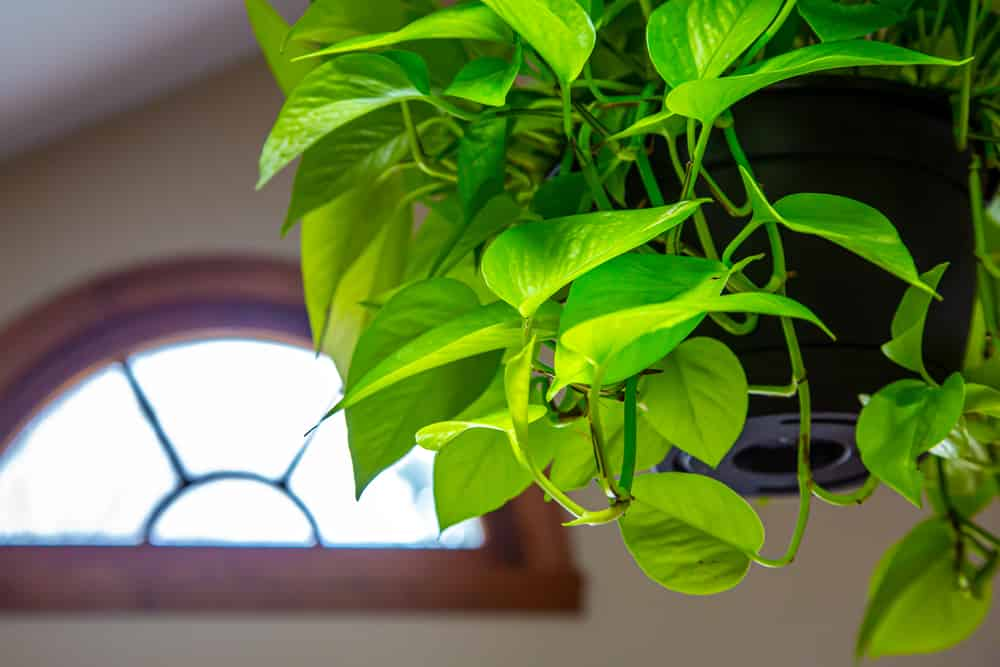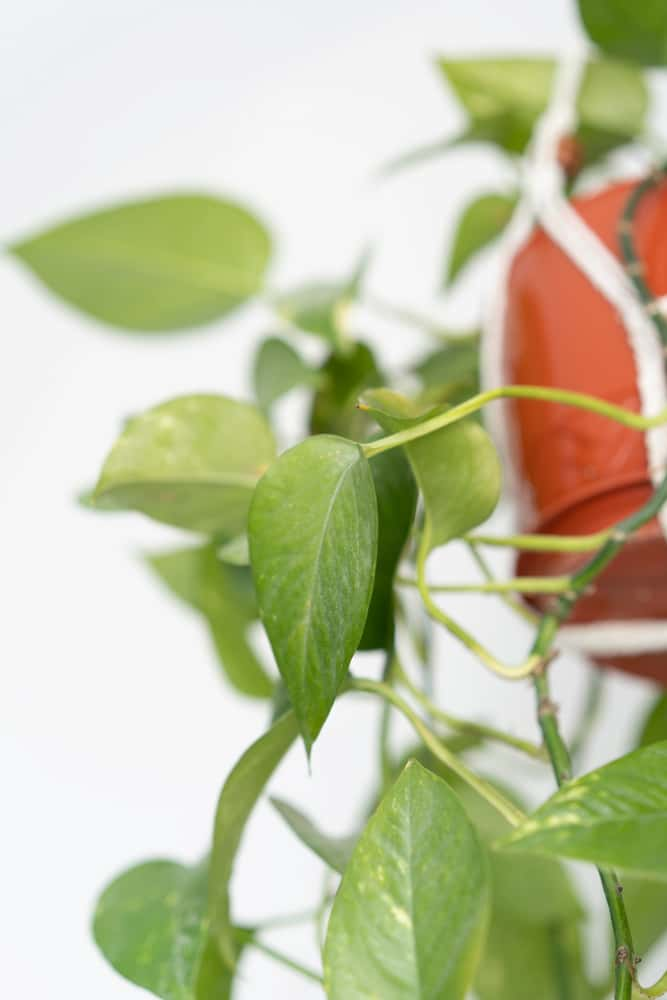If you’re looking for an easy-going, low-maintenance houseplant that can add interest and texture to your home, look no further than a hanging pothos plant.
Pothos are tropical plants that thrive in warm temperatures and bright light. They can tolerate a wide array of conditions and can provide your home with years of joy.
And there’s no question that having one hanging from your ceiling can really elevate a room. Sure, they look pretty great on side tables and shelves. But having one up at eye level (or higher) will really get a second look in any space.
Keep reading to find out how to care for a hanging pothos so it thrives.

Table of Contents
Are pothos good hanging plants?
Pothos work well when grown in hanging baskets. This is because pothos have a natural trailing or hanging tendency, which is ideal for hanging baskets. Alternatively, you can grow pothos in traditional growing containers with a pole, trellis, or stake for them to climb up.
In addition, pothos plants are basically impossible to kill, so even if your pothos isn’t thrilled initially at being moved into a hanging planter, it will soon get over it and be back to its happy self.
How do you take care of a pothos hanging plant?
Pothos are not fussy plants, and can actually tolerate a wide array of growing conditions. That doesn’t mean, however, that you shouldn’t strive to give this plant the care it needs for optimal growth.
1. Well draining soil
Your hanging pothos plant will need soil that isn’t compact and instead is light, airy, and drains well. A good soil mixture for hanging pothos plant contains 1 part sand or vermiculite, 1 part shredded bark, 2 parts perlite, and 4 parts coco coir or peat moss.
Alternatively, you can use a high quality potting mix for your hanging pothos plant without any problems. Just make sure that the mixture drains well.

2. Water when needed
Expect to water your hanging pothos plant about once every week or two. Pothos do not like to sit in soggy soil, so you should only water the plant when the top 1 to 2 inches of soil is dry. Use your finger to determine the soil moisture level of the hanging pothos plant before watering.
FYI: Overwatering a hanging pothos plant is a serious concern, so care must be taken not to water this plant too much.
While underwatering a hanging pothos plant should also be avoided, it is not nearly as damaging to the pothos as overwatering.
3. Bright, indirect lighting
For optimal growth, place the hanging pothos plant in an area that has bright light that is out of direct sunlight. If you don’t give the plant enough light, it will experience stunted growth. If, however, the plant is placed in direct light, the leaves of the hanging pothos plant will burn, scorch, and discolor.
Related: What Are Your Pothos’ Light Needs (So Your Plant Can Thrive)?
4. Consistent temperature and humidity levels
Higher levels of humidity in hanging pothos and warm temperatures is essential for the best results. Temperatures that fall between 65 and 85 degrees and humidity levels at around 60 percentage percent will help keep your hanging pothos plant healthy and strong.
Keep in mind that pothos are susceptible to temperature fluctuations and can cause harm to your hanging plant. Because of this, you should take care not to place the hanging pothos plant in an area where the temps drastically go up and down. Areas like underneath a heating and cooling vent or near the front door can cause problems with your houseplant.

5. Regular feeding
Pothos are not heavy feeders, but you should still fertilize them once a month during their active growing season, which is in the spring and summer months. The best fertilizer for a hanging pothos plant is an all-purpose fertilizer that is water soluble, such as 10-10-10 or 20-20-20.
6. Occasional pruning
Pruning is useful to help control the size and shape of the hanging pothos plant, while also encouraging healthy growth. Always use a sharp and clean pair of pruning shears when you prune and cut just above a leaf node. Pruning hanging pothos plant should only be done when the plant is actively growing.
Pro tip: Instead of throwing away the pruned off stems of your hanging pothos plant, consider using them as cuttings by rooting them in water or soil.
To speed up the rooting process, dip the cut end of the stem in rooting hormone. Just remember to only use pothos cuttings that are healthy and not diseased.
7. Check for pests and diseases
As with other houseplants, snap-sucking insects like mealybugs, spidermites, aphids, and scale, can attack pothos. These insects are usually more of an annoyance than a serious threat, and can be treated with insecticidal soap or hortocultural oil.
While pothos are not susceptible to too many diseases, the fungal disease known as root rot is the most serious one that you should be concerned with. Root rot occurs when the plant is overwatered, has poor draining soil, or both. The good news is that this disease is easily prevented by simply not overwatering the hanging pothos plant.
Find out more: 9 Clear Signs of Pothos Root Rot (and How to Fix It)
Where should I hang pothos?
Your hanging pothos plant should be placed in an area where the vines can safely cascade downward without getting tangled or damaged by other objects. Ideally, you should hang the basket 2 to 3 feet away from an east- or south-east-facing window.
Remember, however, that pothos grow best when they have bright indirect light. Keep this info in mind when trying to decide where you should place your hanging pothos plant.

Where to find hanging pothos for sale?
Hanging pothos plants are available for sale from various online and offline merchants. Visit your local garden center or nursery and you should find a small section of pothos available for purchase. If your local area is a bust, consider purchasing a hanging pothos plant from an online plant company.
Check social media for local gardening groups as they sometimes host plant swap events where members can exchange cuttings or even whole plants without other members.
Why are my hanging pothos plant’s leaves turning yellow?
There are several reasons as to why the leaves on your hanging pothos plant are turning yellow, and one of them is age. As the plant ages, leaves often start discoloring and turning yellow. This is a natural process and not something to be concerned with, but it is far from the only reason.
Direct sunlight, incorrect temperatures, and too much fertilizer can also cause the hanging pothos plant leaves to turn yellow. Thankfully, these are easy fixes, but do require some work on your part. This could include moving the plant out of direct sunlight, ensuring the temperature is at least 65 degrees, and stopping all feeding of the pothos.
